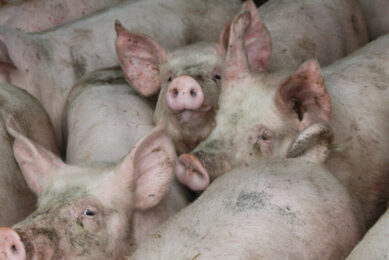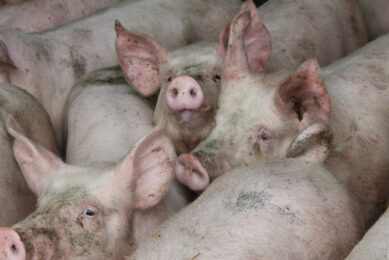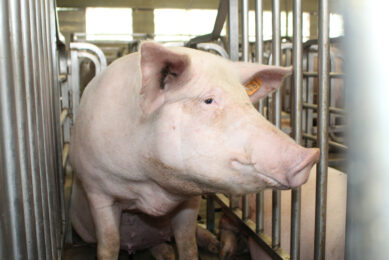Health and productivity – ‘Disease control is king’
‘Disease control is king’ and ‘Pigs are precious’ were two of the remarks made by John Dean, professor at Minnesota State University at a recent conference in Rovereto, N. Italy. Analysis of the major components of production profitability variation were the CDL group (culls, deads and lightweights) which accounted for 55%, followed by feed conversion efficiency (FCE) at 28% and finally average daily (ADG) gain, 17%.
‘Disease control is king’ and ‘Pigs are precious’ were two of the remarks made by John Dean, Professor at Minnesota State University at a recent conference in Rovereto, North Italy. Analysis of the major components of production profitability variation were the CDL group (culls, deads and lightweights) which accounted for 55%, followed by feed conversion efficiency (FCE) at 28% and finally average daily (ADG) gain 17%.
Even in the face of high feed prices, the amount of kilogrammes of good quality meat that goes out of the finishing shed is the most critical component production-wise. One could say ‘Kilos are King’.
The most damaging effect on productivity and profitability is disease. I have seen producers increase the pig size from 100 to 120 kg to try to compensate for a nearly 20% mortality, cull and lightweight scenario, following chronic porcine circovirus type 2 (PCV2) infection.
It also follows on from my previous weblog, where some countries have a 30-35% mortality/ cull problem from a combination of diseases.
Difficult
Attributing the effect of a particular disease to an individual herd and its performance is difficult. It depends on a number of factors such as housing, management, hygiene and immune status of the herd, which consequently affects the challenge of the infection and the severity of the expression of the disease. Multiple infections are even harder.
In a very recent report from Denmark (Nielsen and others, 2008), they surveyed 74 case farms with recent clinical PCV2 infections or typical post-weaning multisystemic wasting disease (PMWS) and 74 which did not, as controls (see Table 1).
Table 1. Case control study of PMWS on 148 farms in Denmark
Case herds (+PMWS) | Control herds | Difference | |
Weaner mortality (%) | 11.2 | 3.1 | 8.1 |
Weaner ADG (g) | 392 | 428 | -36 |
Finisher mortality (%) | 5.2 | 3.2 | 2.0 |
Finisher ADG (g) | 777 | 829 | -52 |
The higher weaner mortality in the early stages is expected, especially in the early stages of breakdown, as well as in the finishers, but the level of reduced growth rate of 52 g in the finishers was probably higher than expected but actually has been previously reported as a 5-7 kg/pig drop in liveweight in finishing sheds. This may account for the comments we have had back from the field, ‘that we did not know how badly PCV2 was affecting performance until we started vaccinating against it’.
Pig finishing house
So if we take a 1,000 pig finishing house, taking pigs from 25-100 kg in 100 days and the price is €1/kg liveweight, for simplicity. It does not include any variations for poor grading or effects on FCE. Let’s look at the impact of some diseases on productivity (see Table 2) as an approximate guide.
Table 2. Effects of various diseases on production efficiency in a finishing house
Disease | Mortality/Cull (%) | Growth rate reduction (g) | Batch production value (€) | Efficiency (%) | |
1 | No disease | 0 | 0 | 100,000 | 100 |
2 | Non-disease losses | 2 | 0 | 98,000 | 98.0 |
3 | PMWS/PCV2* | 2 | -52 | 91,008 | 91.0 |
4 | Enzootic pneumonia | 1 | -37 | 93,411 | 93.4 |
5 | PRRSV | 1.2 | -37 | 93,218 | 93.2 |
6 | PRDC | 4.2 | -126 | 81,981 | 82.0 |
7 | Ileitis | 1 | -35 | 93,605 | 93.6 |
8 | Colitis | 0 | -30 | 95,060 | 95.1 |
9 | Swine dysentery | 2 | -70 | 89,280 | 89.3 |
10 | Mixed enteric infection | 3 | -135 | 82,175 | 82.2 |
Key: * from Table 1
PRRSV – Porcine reproductive and respiratory syndrome virus
PRDC – Porcine respiratory disease complex – sum of line 3, 4 & 5
Mixed enteric infection – sum of 7, 8 & 9
As the number of diseases or co-infections builds up on a farm, one can see what a dramatic effect those lost kilos can have on production efficiency and profitability.











